THE CONCEPT
Hajj is among the five pillars of Islam, being the last pillar; it is not made compulsory for all Muslims, but only for those who can afford it.
The Glorious Qur’an (3:97) says: “Pilgrimage thereto is a duty men own to Allah – those who can afford the means”.
Most Islamic practices revolve around unity and brotherhood.
The prayer (Salat) for instance is in essence the coming together of the believers to worship Allah together in a mosque. Every small group of Muslims gathers five times a day for that purpose. Then, this extends to weekly Friday prayers of a larger Muslim community to come together and pray.
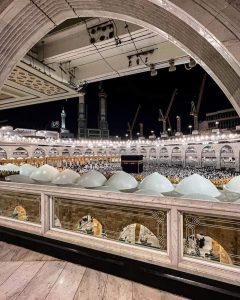
The spirit of coming together to pray extends further to two annual Eid prayers. The first is called Eid-ul-Fitr (the festival of fast-breaking). It falls on the first day of Shawwal, the tenth month of the Muslim year, following the month of Ramadan in which the Qur’an was revealed and which is the month of fasting.
The second is called Eid-ul-Adha (the festival of Sacrifice). It falls on the tenth day of Dhul-Hijjah, the last month of the Muslim year, following the completion of the rites of Hajj Pilgrimage to Makkah.
Each Eid is a thanks-giving Day when Muslims assemble in a brotherly and joyful atmosphere to offer their gratitude to Allah for helping them fulfil their spiritual obligations. This form of thanks-giving is not only confined to spiritual devotion and verbal expression; it goes beyond that to manifest itself in a good social and humanitarian spirit.
Muslims who have completed their fasting of Ramadan express their thanks to Allah using distributing alms among the poor and needy on the first day of Eid. Similarly, those who have completed at Makkah, as well as those who are at home offer their sacrifice by slaughtering rams and giving out alms to be distributed among the poor and needy.
This distribution of alms constitutes a major part of the two Eids. This Islamic form of thanks-giving is a wholesome combination of spiritual devotion and humanitarian prayers benevolence.
Each Eid is a day of peace. Once a person is at peace with Allah, he is at peace with himself and consequently with the rest of mankind.
The last and the largest place, where Muslims worship annually, in this world is Ka’abah during the Hajj. Here, Muslims from all over the world meet every year. Over two million people gather together in one particular place to offer prayers.
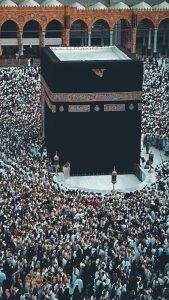
The mammoth of the crowd could be similarly likened to the crowd on the Day of Judgment (Reckoning) when all mankind, the Jinns, and the Angels will gather in one particular place before the Almighty Allah. There, every individual will account for his or her actions during his or her sojourn on earth.
The origin of the Ka’abah can be traced to Prophet Ibrahim (AS) who laid the foundation stone for a community in a deserted place by the order of Almighty Allah. Thereafter, he settled his wife, Hajara (Hagar), and his son, Ismail (Ishmael).
The place was arid land and without water. The thirsty child, Ismail in desperation for water rubbed his heels on the ground suddenly and unexpectedly water started sprouting and gushing out.
Allah made provision for water at that place called “Zam Zam”. Slowly the place became populated and was called Bakkah or Makkah. This was the place where Prophet Ibrahim (peace be upon him) found lost signs of the first House of Allah that was built for his worship (i.e. before the earth was flooded).
He rebuilt it with the help of his son Ismael. Prophet Ibrahim (AS) fervently prayed to Allah (Q.1437) to make the House a “Place for Humanity” and to rise from the progeny of Ismail living in the area of the greatest Prophet (Muhammad PBUH) who would be merciful for all mankind. Before the advent of Islam, there were 360 idols inside the Ka’abah, each idol representing a particular Arab tribe.
Annually they converged in the place to appease their gods and goddesses in the form of pilgrimage. When Islam came after the conquest of Makkah, all the idols were destroyed and the jahiliyyah Pilgrimage was discarded and replaced with the Islamic Holy Pilgrimage.
The focus of the pilgrimage is Ka’abah which was built by Prophet Ibrahim and his son, Prophet Ismail (peace be upon them) some 4000 years ago. Today, Ka’abah stands in the middle of a large courtyard of Masjid al-Haram or the Sacred Mosque.
Ka’abah is the first house that was built for the worship of one and only God, Allah. It is also called “Baitul-lah” (House of Allah), “Al-Bait Al-Ateeq” (The Ancient House) and “Al Bait al-Ma’amoor” (Inhabited House). This House and the places around it have several signs that have manifested the wonders of Allah.
For instance, the courtyard of Masjid al-Haram contains besides Ka’abah, the Maqam-Ibrahim (station of Ibrahim), the fountain of Zamzam, the Hateem which is inside the Tawaf and a prayer in these areas is as good as that offered inside the Ka’abahitself.
Mulatzam is the southern part of the wall between the door of the Ka’abah and the Blackstone. Another one is the Rukn-al-Yamani (Yemen’s pillar). Others include Mataaf, the marbled open space around the Ka’abah.
This is a place where the circuit of the Holy Ka’abah is performed during pilgrimage. Masjid al-Haram is also a Mosque that has a rectangular shape with rounded corners. Pilgrims also offer prayers in this Mosque which can accommodate about two million people.
Last but not least is Safa and Marwa, two hillocks located to the north of Masjid al-Haram. Hajara, the wife of Prophet Ibrahim (AS) is believed to have run seven times between the two hills in desperate search of water for her child Ismail. Pilgrims are also ordained to emulate this action of hers.
Muslims all over the world face the Ka’abah to offer prayers. Allah, the Exalted says in the Holy Qur’an: “Surely, the first House appointed for mankind is that at Bakkah (ancient name for Makkah) abounding in blessings and guidance for all people.
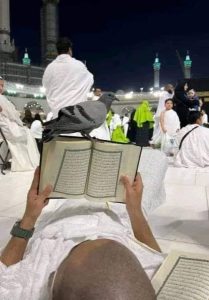
In it are signs: it is the place of Abraham: and whoever enters it, attains peace” (3:96-97).
Another important aspect of Hajj is the stay in the plain field of Muna for two or three days. During this period, a Pilgrim is expected to compose himself or herself to the meditation of Allah. It is a period for sober reflection.
While in the second day of Muna i.e. on the 9th of Dhul-Hijjah, the pilgrims will move to another field called Arafat and stay there from sunrise to sunset, when all the Pilgrims would again move to the field Muzdalifah and spend the night of 9th Dhul-Hijjah to the morning of 10th Dhul-Hijjah, leading to the Ka’abah for circumambulation and Sa’yi.
These entire fields are within less than a 10km circuit and have some spiritual values. For instance, the fields of Muna, Arafat and Muzdalifah are believed to be one place where the first creation of mankind (Adam and Eve) first settled on earth.
It is also believed that it is the same place where all mankind will gather on the Day of reckoning (Allahu A’lam) only Allah knows. When the Prophet Muhammad (SAW) perceived that his days were numbered on earth, he gathered all his faithful and declared that: Allah says: “Today, I have perfected your religion for you, and have chosen for you the religion of Islam”.
This event took place specifically at Mount Arafat.
On the same day after Sa’yi, the Pilgrim should also observe the throwing of pebbles at Satan (Jamarat). The genesis of this exercise emanated from the time Allah (SAW) ordered Prophet Ibrahim (AS) in a dream to sacrifice his only son Ismail.
As Prophet Ibrahim (AS) proceeded to execute the order of the Almighty Allah, Satan first appeared to the Prophet Ibrahim (AS) urging him not to sacrifice his only son and Prophet Ibrahim cast a pebble of stone on him and also cursed him, this place is known as Jamarat al- Aqaba where the first Jamarat was positioned.
The Prophet Abraham (AS) also moved further, the Satan still appeared urging him to go against the command of Allah (SWA); the Prophet again threw another pebble of stone at him also cursing him. This is where the position of the second Jamarat still lies.
Satan again appeared for the third time in the same approach and the Prophet repeated the same action by casting and cursing him, where also the position of the third Jamarat is situated.
Pilgrims are also enjoined to emulate the throwing of pebbles on these three points just to curse and keep away from Satan in the same way the Prophet Abraham (AS) did when he was confronted with Satan.
The first throwing day is on the first point of Jamarat called Al- Aqaba with seven pebbles, while the second and third days are to be thrown on all three Jamarat points with seven pebbles each numbering twenty-one pebbles for each day.
Pilgrims are strongly warned to desist from observing the exercise of throwing Jamarat while carrying luggage of any size and should strictly follow the wave of the direction of a crowd and never in the opposite direction.
The exercise of Jamarat could be performed in a proxy that is strong and healthy and can be performed for the old, weak and sick.
During the three-day stay in Muna, the concepts of unity, equality and brotherhood come into play again. All the male Pilgrims put on only small white loin garments regardless of his or her status in society.
The female pilgrims are also expected to dress decently in whichever dress regardless of colour. The stay in Muna, standing at Mount Arafat and spending the rest of the night at Muzdalifah are the essentials of Hajj performance.
The Intending Pilgrims are also requested to visit the Prophet’s Mosque in Madinah, even though the visit is not part of the Hajj essentials. The visit could be either before or after Hajj, depending on the time an Intending Pilgrim arrives in the Saudi Kingdom.
The number of days to stay in Madinah was not limited, this is against the wrong notion that a Pilgrim must stay in Madinah for seven days.
Apart from the prayers in the Prophet’s Mosque, a Pilgrim could also visit some places of historic importance in Islam. For instance, the visit to the tombs of Prophet Muhammad (SAW) and some rightly guided Caliphs; Abubakar and Umar, (may Allah [SWT] accept them).
There is also the site of a graveyard for Mujahideen within the vicinity of the Prophet’s Mosque. A Pilgrim is expected to offer some prayers for the repose of their souls during the visit.
Lastly, there are the fields’ battle of Uhud and the Badr where the Prophet Muhammad (SAW) fought with Makkan’s pagans and the graveyard of some Prophet’s companions like Sayyidna Hamza, who were killed and buried on those fields.
Abubakar Bello Ka’oje is the Deputy Director Monitoring and Evaluation Unit, NAHCON, he writes in from Abuja.



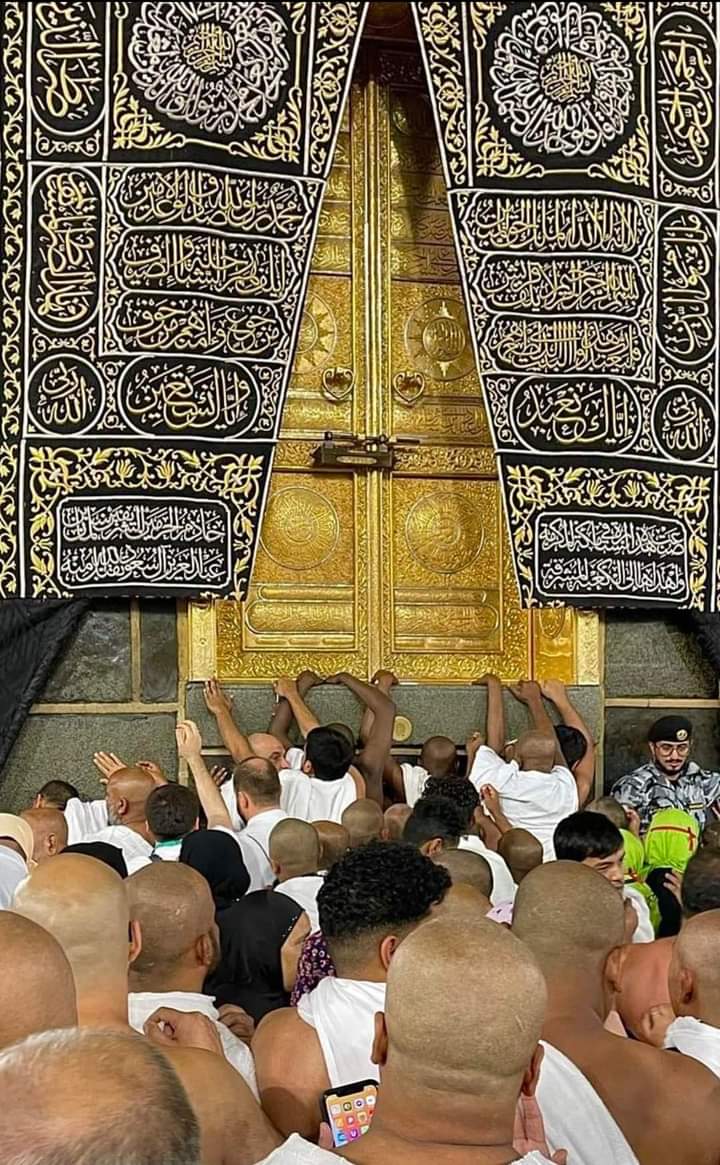



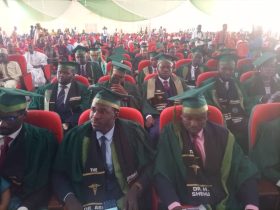



Leave a Reply